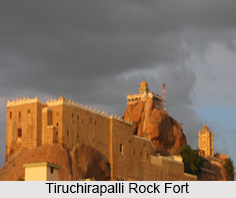 Built on an 83 m high ancient rock, the Tiruchirapalli Rock Fort is located in the city of Tiruchirapalli in the Indian state of Tamil Nadu. It is a historic fortification and temple complex, with the Ucchi Pillayar Temple, Thayumanaswami Temple and a Ganesha temple from the Pallava era that attracts tourists in the fort premises. The Rockfort is the most prominent landmark of the city.
Built on an 83 m high ancient rock, the Tiruchirapalli Rock Fort is located in the city of Tiruchirapalli in the Indian state of Tamil Nadu. It is a historic fortification and temple complex, with the Ucchi Pillayar Temple, Thayumanaswami Temple and a Ganesha temple from the Pallava era that attracts tourists in the fort premises. The Rockfort is the most prominent landmark of the city.
Etymology of Tiruchirapalli Rock Fort
In the ancient days, during the time of the Vijayanagara Empire, military fortifications were common. And thus the name "Rockfort" came into place due to the frequent military fortifications in the area, first by the Vijayanagara Empire and later by the British Empire during the Carnatic Wars.
History of Tiruchirapalli Rock Fort
The construction of the Tiruchirapalli Rock Fort started sometime in the 580 and the oldest structure within the fort premises is a cave temple which was built by the Pallavas during that period. The turn of the 10th century brought the Chola dynasty to power and Tiruchirapalli continued to be in their possession until the decline of the empire, after which it became a Vijayanagara stronghold. The Tiruchirapalli region along with the Tiruchirapalli Rock Fort passed several hands over the centuries and even came under the possession of Delhi Sultanate after Malik Kafur"s raid on South India. But the Islamic conquerors were ousted and in the 16th century, the area came under the Madurai Nayaks and it was under them that Tiruchirapalli prospered. The Madurai Nayaks constructed the Rock Fort Temple Lake along with major walls as foundations, establishing the town as a trading city and later, their capital.
Since Rockfort was the capital of the Madurai Nayaks, the Tiruchirapalli Rock Fort has witnessed several fierce battles. One of them being the Battle of Toppur, which was the largest of the lot, fought between the Aravidu dynasty of Vijayanagara and the Madurai Nayaks. The former won but the Nayaks faced fierce attacks from Adil Shahi, Mysorean and Imperial Maratha troops. During their rule, they had occasional encounters with the Thanjavur Nayak kingdom, the Thanjavur Maratha kingdom, and more frequently, with the invading Adil Shahi, Kingdom of Mysore, and Imperial Maratha armies.
During the mid century, Chanda Sahib, aided by the French, made this fort his home base. He battled with the combined forces of the Carnatic Nawab and British. He was defeated in the Carnatic wars and was forced to cede his lands to the British. And thus with the advent of the British era in the 18th century, the town of Tiruchirapalli was firmly established as a Cantonment town and the fort`s gate was known as main guard gate. Robert Clive lived near the tank when he was in Tiruchirappalli.
Architecture of Tiruchirapalli Rock Fort
The ancient rock atop which the Tiruchirapalli Rock Fort is built is over 3.8 billion years old and is thus known to be one of the oldest rock formations in the world. The fort and the temples built on it represent the Indo Saracenic Dravidian architecture. The two rock cut temples within the fort premises are similar to the rock cut temples of the Pundarikakshan Perumal Temple at Thiruvellarai and Pechipalai cave temple.
Visiting Information on Tiruchirapalli Rock Fort
The Tiruchirappalli Junction is the closest railway station at a distance of 5 km from the Rockfort and the Tiruchirappalli International Airport is the nearest at a distance of about 16 km from the Tiruchirapalli Rock Fort.



















